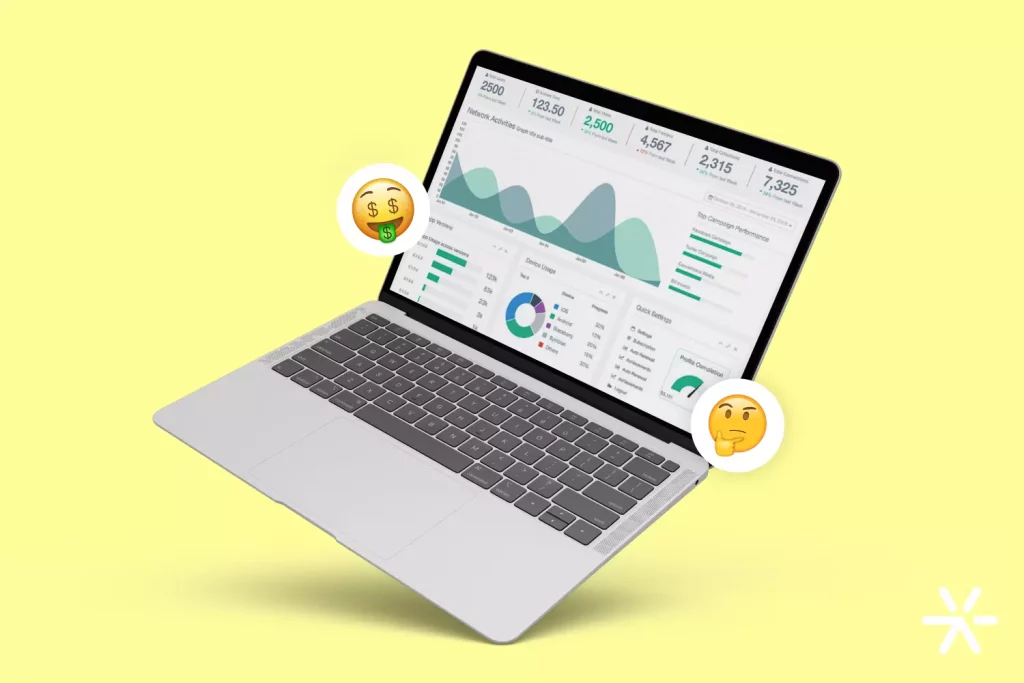Market Share: How to Measure and Understand Your Position
A lot of people already know what Market Share is. But not everyone knows that this concept can be directly applied to various businesses, not just the giants.
Some people really believe that the concept of Market Share only applies to multinationals and companies that generate hundreds of millions per year. And these people end up missing out on a very important organizational strategy.
Understanding Market Share is a task for all entrepreneurs, even at a local or regional level. Through it, you can identify growth opportunities and pinpoint your main challenges in expansion.
Today, that’s the topic: I’ve brought some deeper explanations about what Market Share really is, some data on global sectors, as well as the Market Share of the largest companies in the world.
And of course, to wrap up, I’ve included some tips to help you understand your own Market Share, no matter what segment, region, or business classification by revenue you belong to.
So let’s dive in—this topic is super interesting:
What is Market Share?

Market Share is a term related to your performance in the market you are in. In other words, it’s how much of that market you dominate with your products or services.
Basically, that’s it! The concept of Market Share is one of the simplest to explain in the corporate world. It refers to the impact a specific brand has in its area of operation.
But even though it’s so simple to explain, Market Share is quite complicated to measure accurately—especially as brands grow larger.
Most of the time, Market Share is calculated by audit companies hired by businesses that want to know their own.
In the case of large companies, it’s also measured with the support of the country’s regulatory agencies. For example, telephone companies and ANATEL work together to understand Market Share and share it across the country.
This is a very important transparency effort, aimed at preventing monopolies and cartels. At the same time, it’s very useful for companies that seek to understand how well their products and services are being adopted.
But how does this work in practice? Let’s delve a little deeper into the calculation of Market Share.
What is the formula for Market Share?
Calculating Market Share isn’t that complicated. As we’ve discussed, it’s related to your representation in the market.
What the calculation does is standardize what this representation means. It’s important because all companies use the same calculation as a basis to define their own Market Share.
However, it’s important to note that this type of calculation is absolutely volatile. But we’ll discuss this more in the next section.
For now, see the formula below:
Market share = (Your revenue / Total industry revenue) X 100
With this calculation, you’ll understand your Market Share according to the entire competitive landscape of your segment.
What is relative Market Share?
Relative Market Share is another very similar calculation but with a different objective: it describes how close you are to the top of your Market Share.
Basically, it’s not comparing your revenue to the entire segment, but rather to the current market leader’s revenue.
This is another pretty simple calculation, but the tricky part is obtaining your competitor’s revenue information.
Publicly traded companies are easier to analyze, for example. But dealing with close competitors or knowing the revenue of a startup can be much more difficult than you might imagine.
Before the end of the article, I’ll bring some interesting tips on how to achieve this result, okay? Don’t worry. For now, see the formula below:
Relative Market Share = (Your Market Share / Your competition Market Share) X 100
But there are some more in-depth analyses of the Market Share concept itself that are worth discussing. See below:
Methodological differences in calculating Market Share

It turns out that this way of calculating Market Share is the main one, but it’s not the only way.
There are disagreements among specialists and economists about the best way to calculate it, and even whether it’s possible to calculate it with 100% accuracy.
It may seem strange that such a calculation is so difficult to understand as the standard, right? But in fact, these disagreements make a lot of sense.
Market Share is a very strategic metric for companies. It’s quite common that, besides the points we’ll show here throughout this section, others also arise, this time related to companies’ reluctance to disclose their actual numbers.
But these are much deeper economic issues. For now, let’s focus on three key points of divergence that are very important for understanding not only what Market Share is but also how it’s interpreted.
Shall we?
Units vs. Capital
The first point of inflection about what Market Share is and how to calculate it is related to the main observation point.
What should be considered in the calculation: the number of units produced and consumed by retailers and customers, or the amount of capital moved through sales?
This is particularly important in retail. For example, if the calculation only considers the capital moved—i.e., the revenue—other questions need to be raised.
For example: exchanges and returns, delivery costs, marketplace fees, etc. All of this impacts revenue, but it’s not related to the market share the company occupies at the moment.
When we only consider the units produced and delivered to the market, we get a good idea of the number of products leaving the factory and entering the market.
But this completely ignores other issues, such as production process failures, products sitting on shelves, etc.
Both approaches have flaws, like any economic analysis. But both can at least approximately express who the main players in a segment are.
Logistics vs. Consumption
Ah, but we can complicate the issue of Market Share a little more. There are still two other interpretations of product movement: what counts—the process of delivering to retailers or consumer purchases?
It may seem like a minor detail, but it’s not at all.
If we consider the units produced with a set destination, we’re thinking about the B2B market. And this market is also part of a company’s Market Share.
If we think only about consumed units, we’re thinking about the B2C market.
If that’s your case, I recommend considering both: how much you sell to retailers and how much your products move.
These complexities make the Market Share calculation quite complex. It’s normal—you’ll never have a 100% accurate idea of it. The best thing to do is always try to get as close to an answer as possible.
Market Definition
What we discussed just now about B2B and B2C is a classic issue when thinking about what Market Share is.
Global companies also suffer greatly from this, especially when calculating Market Share in their home country.
What should be considered as the market when doing the calculation? Which industries and companies are really competitors?
These market definitions are very difficult to determine with certainty. Once again, it’s important to think of the numbers as approximations and not as determining who is “winning” or “losing” in a competitive scenario.
Now that we understand what Market Share is and realize it’s quite difficult to determine any Market Share with certainty (😅), we’re ready to understand some examples in more depth.
Shall we start by understanding the Market Shares of five major segments of the global and Brazilian markets?

Market Share Examples by Segment

Important: Before we begin, it’s important to reinforce some points we’ve discussed throughout the article so far.
First: This information is approximate by nature. That’s how Market Share works, and that’s how most economic indicators related to other companies work as well.
Second: In some cases, like the SaaS segment, Market Share is much simpler to calculate because another variable comes into play: the number of paying users.
In the SaaS segment, revenue is obviously tied to the number of users you have, not how many products you send to your suppliers, for example.
This brings us to the third and final point before the analyses: the measurement methodology will change according to the market.
All the issues we discussed in the last section are closely related to similar markets. But different markets adapt and adjust to their realities when understanding what Market Share is.
Shall we proceed with the analyses?
SaaS Sales CRM
The data here comes from Statista and was updated in March 2023. Unfortunately, to access the exact figures, you need a professional account on the site.
However, the study at least gives a broad overview, showing a global dominance by Salesforce, although it doesn’t even account for half of the “Others” category.
This means that the CRM sales market share is closely tied to the options available in each country. Instead of one large CRM dominating worldwide, the global market share is dispersed across various countries.
The main players by market share are:
- Others
- Salesforce
- Adobe
- Oracle
- Microsoft
- SAP
- Genesys
- HubSpot
- Zendesk
Market Share of Email Marketing Platforms
The information here is from Datanyze, and it is also related to SaaS metrics, so the controversies we discussed earlier affect the data less.
Once again, the information is global. See the main email marketing platforms in the global market:
- Mailchimp: 65.81%
- Klaviyo: 9.49%
- Constant Contact: 5.81%
- Mailjet: 4.11%
- MailerLite: 2.23%
- Elastic Email: 1.89%
- Campaign Monitor: 1.78%
- AWeber: 1.38%
- Acyba: 1.15%
- CleverReach: 0.7%
Examples of Market Share by Companies

Since you’ve read this far, a bit of fun before we dive into the final practical topic: how about a Big Brother-style peek at the world’s largest companies?
I’ve gathered here, with the help of HubSpot, the market shares of the biggest startups and tech companies worldwide.
It’s important to talk about technology because this is the fastest-growing segment globally. The market shares of the companies we’ll showcase here have direct impacts on various areas.
Let’s delve into this in the items below. See:
Google is the most popular search platform in the world, with a market share of 92.37%. Its main competitor, Bing, has only 3.57% of this market.
This isn’t surprising and has direct impacts on current digital marketing. Inbound Marketing, for example, and SEO are strategies primarily focused on the search engine.
Google is everywhere and isn’t going away anytime soon. It has been heavily investing in future technology, like Artificial Intelligence, to avoid falling behind as Microsoft integrates ChatGPT with Bing.
This massive dominance by Google can be explained by several factors. It was the first search engine to popularize and become the standard worldwide, and its functionalities go far beyond a simple tool for finding things on the internet.
Today, Google is practically a media empire. Everything that isn’t owned by it depends on it. But let’s look at some other slightly more modest examples:
Spotify
Don’t get me wrong: a 92% market share is indeed an impressive figure, but in Google’s case, I think everyone already knew about its total control.
Spotify is similar, but its indicator is a bit more interesting and tells a story. Today, 31% of the music streaming market is controlled by the green giant.
This figure tells a story because Spotify, even with 31%, is the largest in the market. The other 69% are scattered across local services and other platforms (such as YouTube Music and Deezer, for example).
And we’re not even counting piracy here since it’s impossible to measure. Such fierce competition is always interesting: it means more features for users, a greater focus on usability, and marketing techniques that work for everyone, like shows, sponsorships, and events.
Nike
Nike is the global leader in the market share of sneakers and sportswear, with 43.7% of the entire market worldwide.
This also isn’t a big surprise. Nike is a very old company, and over its decades, it has never failed to innovate and offer the best products possible for all styles and budgets.
But how does this happen? How does a company that was once small suddenly become the largest in the world in its field? That’s what we’re going to discuss now.
I’ve gathered here some tips to help you expand your market share on four different levels: locally, regionally, nationally, and then globally.
How to Increase Your Market Share

Increasing market share is a slow process that involves a lot of investment, and of course, great marketing.
Many companies find themselves stuck in their current structures mainly due to investment. The insecurity of growing in already established local companies is real, and it’s a very fair feeling to have.
The thing is, for a company to grow, it needs to take some leaps of faith. But these leaps don’t need to—and in many cases, shouldn’t—be too big. Scalability can be done gradually, one step at a time.
That’s why I’ve gathered some tips here that range from the local level to the global level, but going slowly, step by step, first through regional growth and then national.
Let’s learn more now:
Increasing Local Market Share
Local companies are the most protective when it comes to investments. Often, they can’t find space to grow due to this difficulty in raising capital for the necessary actions.
But this is the first step to increasing market share: seeking investment opportunities and raising capital to make that investment happen.
Each company is in a very specific situation, and it would be impossible and even irresponsible for me to provide a specific step-by-step since I don’t even know what your area of operation is, right?
But this need is urgent: always gather capital and look for opportunities to expand. Especially by opening new franchises in areas where your business is needed, and competition is low.
This is another point, by the way: invest in gathering data about your market’s state. Expansion is only possible if you know where the opportunities are.
Look for blind spots in your segment within your city. And then in neighboring cities. Start small, offering deliveries (if you’re in retail) and on-site services if you’re in the service sector.
This alone will require the most common investment in local businesses: purchasing a fleet of vehicles. With it, you gain enormous mobility, which will accompany you in the next steps of your expansion.
And speaking of those steps:
Increasing Regional Market Share
This is one of the most important leaps you need to make, but one that many businesses end up ignoring and preferring to jump straight to national expansion.
Regional market share starts by expanding from a website. In fact, this is a step you need to have completed even to increase your local relevance.
A website is necessary because you’ll need to run targeted campaigns on Google Ads and Social Ads. Through them, you can make ads targeted at your audience with geographic segmentation.
For example, you are from Ribeirão Preto and want to take your operations to a higher level in the Triângulo Mineiro. You can configure your ads to appear only to people or companies in that region.
Meanwhile, the investment cannot stop. Now is the time to establish a robust marketing budget and not reduce it. Expanding companies can have marketing expenses that easily exceed 15% of their revenue.
Increasing National Market Share
This is quite a significant challenge. Transitioning from regional to national requires a series of investments, both in your company’s structure and in the resources you have for expansion.
The company will need to undergo a series of audits to improve its project management and standardize them under a standard methodology, such as PMI, Lean, or Agile.
If you work in a startup or with SaaS product sales, this expansion often comes with a greater focus on Product-Led Growth. This model allows you to grow without borders and without the need to expand your team, vehicle fleet, office space, etc.—especially due to the possibility of working 100% remotely.
Increasing Global Market Share
If you are at this level, it’s likely that you already know the ropes for global expansion: acquiring new companies.
This is what the vast majority of the world’s largest companies do. They have a predictable revenue stream already established and responsibilities to shareholders to keep it growing.
Investing in new technologies on your own is always very uncertain. Even Google struggled with the launch of its biggest functionality in recent times, which we mentioned in this article: its AI, Bard.
Research & Development investment in new companies is important, but acquiring companies with ideas already tested and approved by the public is even more so.
These are the ideas that keep revenue growing because the investment is simpler and has fewer costs.
That’s why most global companies are not just companies—they are corporations: a collection of other companies and people under a single cohesive identity.
Now that you know what market share is and have a plan for expansion up to the global level, what’s your next step?
Today, the main investment for companies that want to grow is in marketing. Through it, you have a revenue source that increases as you put good work and talented people into your department.
But marketing is not the ultimate savior; it needs these two ingredients—work and talent—always well-aligned.
You can start with the basics: get a chatbot going in your website. Test Leadster today, for free, up to 14 days. No credit card required!







